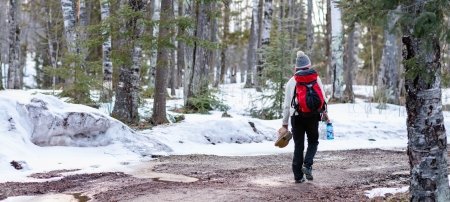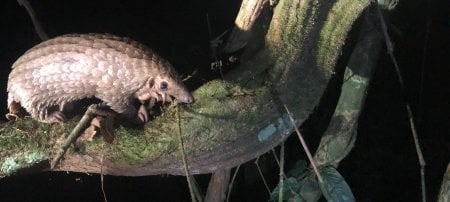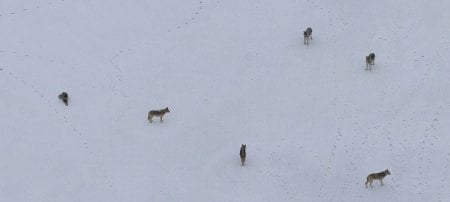Back to Nature
East of the dot-on-the-road town of Shingleton is a section of Highway M-28 known as the Seney Stretch. It is legendary among generations of Tech students, both for the stealthy state cops who patrol its twenty-five-mile length and for the bleak, swampy landscape it transects.
Few students speeding to their homes downstate along this gunshot-straight roadway know about the Seney National Wildlife Refuge. Bordering the Seney Stretch to the south, it is a picturesque haven for thousands of waterfowl. It is also the site of a bold experiment to return nature to the natural world.
Greg Corace ’07 wants to make one thing perfectly clear. Seney National Wildlife Refuge is not about common loons, or bald eagles, or even those greeting-card gorgeous trumpeter swans.
For Corace, head of the refuge’s applied sciences program, Seney is about Seney, all 95,000 acres and everything within. Willows, weasels, and snapping turtles stand no less tall in his estimation than the showiest water birds. What matters is the place as a whole and the forces that created it.
Had he been an ancient Greek philosopher, Corace might have said that Seney was born of earth, wind, fire, and water. But he is a twenty-first century scientist with a PhD in Forest Science from Michigan Tech, so his list is slightly different.
“Fire and water shape this landscape,” he says. “Then beaver.” More recently, humans have had their way with the Seney marshes. Now Corace and others, many of them colleagues at Michigan Tech, are attempting to reweave the intricate net of natural processes that was ripped apart during the last century.
His work began about ten years ago, around the time fellow PhD graduate Charles Goebel ’01 joined him for a walk on the refuge. “I remember Charles turning to me while we were walking the pine islands in the Wilderness Area and saying, ‘This is something special,’” says Corace. “That was about the time my superiors were saying they’d like to build a research program.
“I don’t think they knew what that meant.”
A duck garden
The part of Seney that most people see is largely a human construct. Called Unit 1, it was essentially designed as a waterfowl factory.
“All these large water bodies were created to produce ducks and geese,” Corace says as he drives the refuge pickup along the gravel road. It meanders among Disney-esque pools dotted with swans, wood ducks, and other wildlife. “They are functionally and spatially very different from our more natural water bodies, which are built by beaver.”
The pools had their beginnings in a manmade disaster. In 1908, speculators bought the Seney swamp in northern Schoolcraft County, attempted to drain large portions of it, and sold the acreage as prime agricultural property. However, what they were selling was not fertile Iowa loam, but peatland in a severe northern climate. Most of the farms failed.
In 1935, the federal government stepped in with the encouragement of the State of Michigan and created what would be Seney National Wildlife Refuge, with the primary aim of nurturing migratory water birds, especially those ducks and geese. Over the next twenty years, the refuge built a complex system of artificial pools that now covers more than six thousand acres. Nearly half of those acres are in Unit 1, on the eastern end of the refuge. This is where the offices are and where visitors dawdle along the scenic drive to look at those photogenic common loons, bald eagles, and trumpeter swans.
When you put water in one place, however, you must take it from someplace else. The pools in Seney come courtesy of ditches and dikes that drained tens of thousands of acres of wetland, much of it in the other management units on the refuge, including the largest federal Wilderness Area on the Michigan mainland. More on that later.
“No way on God’s green earth could we ever build these pools today,” says Corace. “What much of our past management did was homogenize the habitats at Seney. Once upon a time, Unit 1 was a mosaic of habitats, with conifers and wetlands. We made it 90 percent water.”
Corace hastens to add that he’s not critical of his predecessors. “Our knowledge has changed, our goals have changed,” he says. “That was a totally different era.” And most of the pools in Unit 1 will stay: they are valuable for the myriad of migratory bird species that breed at the refuge or rest here during their seasonal journeys north and south.
But in another part of the refuge, management is taking careful steps to reinstate natural processes that were disrupted over one hundred years ago.
Don’t call it a controlled burn
Smokey the Bear notwithstanding, periodic blazes define the Seney landscape.
Corace stops the truck and gets out to unlock a gate. We’re leaving the managed pools of Unit 1 and moving westward into Unit 2, where the refuge staff is carefully unleashing the primal forces of water and fire.
“This is the first view of the effects of this summer’s wildfire,” says Corace. Acres burned? “Three grand and change.”
Maybe it was a big deal when flames were licking at the tree trunks, but a few months later, Seney seems to have shrugged off whatever injury the fire inflicted.
“In the past, what words wouldn’t we use to talk about fire?” asks Corace. “Devastation! Catastrophe! Destruction! The fact is, houses may be destroyed, but acres aren’t. Red pine is almost impervious to fire.”
To prove it, he parks near a vigorous old pine nearly three feet in diameter that is almost entirely hollowed out by fire. “This gives you an idea of what these trees will take. That tree is still chugging along,” he says. “They are amazing.”
This red pine and others like it are fire diaries. Scientists can take a wedge out from the bark to the core, look at the growth rings, and date wildfires as old as the trees.
Corace began this fire history work when he was at Michigan Tech with his colleague Charles Goebel, who is now on the faculty of The Ohio State University.
“The first fire we have on our records was in 1592,” says Corace. “We discovered that over the last three hundred and fifty years, there were six landscape-scale fires here, of ten thousand acres or more. The only way we can tell this has been happening is because of big trees like this.”
The last landscape fire was in 1976. It blazed so hot and so deep that it took the next winter’s snows to finally snuff it out.
Most Seney fires aren’t that dramatic, and many are started deliberately by the refuge staff. “The only time you hear about fire is if something goes wrong,” he says. “It’s good for everything, as long as we burn within limits to which this system has adapted.”
But don’t call them controlled burns, Corace cautions. Fires are erratic. “Prescribed” is the preferred term, even in the safest conditions. “I’ve been on a prescribed burn where I’m in water up to my chest dragging a torch across it,” he says.
The prescribed burns nurture Seney’s native vegetation and wildlife and are part of Corace’s ardent effort to bring the marsh back to Unit 2.
“Refuges used to maximize diversity artificially through ponds and hay fields,” he says. Now, the trend is to work within Mother Nature’s natural range of variation. “The red pine and fire work together, a perfect example of an old-growth system that is less species-rich but which provides a natural range of diversity.”
He points toward an old snag across a pool with a tangle of sticks near the top. “You see that?” he asks. “That’s an osprey nest in a jack pine that died in a fire. There’s an example of the natural things working right. Here at Seney, we don’t have to do boxes or platforms to get birds to nest here anymore.”
This natural system has another advantage: it doesn’t support many invasive plants. An exception is glossy buckthorn, but refuge staff battle it using a protocol developed with Linda Nagel, an associate professor of forest resources and environmental science at Michigan Tech.
However, not all nonnatives can be dealt with so easily. Former Michigan Tech graduate student Lindsey Shartell PhD ’12 studied the area’s nonnative earthworms. “We can’t do anything about the earthworms, but what she learns will tell us what we can do with the forest,” says Corace.
Pulling the thumb from the dike
We have driven to the north end of Seney to meet up with Assistant Professor Tom Pypker. The Michigan Tech forest hydrologist is leading before-and-after studies to measure what happens when you start undoing the work of decades.
Seney is not unlike the Florida Everglades. Once, a miles-wide sheet of water flowed through the marshes slowly north to south nearly every spring during snowmelt, dropping ten feet per mile, bubbling through creek, swamp, and groundwater until it finally slipped into the Manistique River and, ultimately, Lake Michigan.
Then Seney was ditched, the pools were installed, and roads were built over dikes linking the bits of high ground. Called pine islands, these small, forested hills rise above the wet marsh and serve as refuges for dry-land critters and the occasional hunter taking a break from stalking through cattails in hip boots.
The dikes disrupted the flow of water across the landscape, creating dry and wet places where all was once various shades of soggy. We’re on top of one of the major offenders, which runs along the Driggs River.
“See how much higher we are than the surrounding landscape?” Corace asks. “They took soil from there and plunked it here to make this dike. That made these pools that we are trying to get away from. This is part of a broken process.”
That process is about to be mended. This summer, the refuge will begin poking holes in the Riverside Dike.
“It will flood the forest where trees have grown in and the water table has lowered,” says Pypker. “And it will allow natural species to come back upstream.”
Pypker and graduate student Meral Jackson are collecting “before” data on the area, describing the hydrology around the dike, as well as the vegetation and how much carbon the area is storing. After the dike is breached and the water begins to flow again, they will track the changes.
Pypker is especially curious about a peatland that’s been divided for decades by the Riverside Dike. “Peatlands represent 20 to 30 percent of the Earth’s soil carbon, and only 2 to 3 percent of land cover,” he says. Restoring the natural flow of water to the area could boost its carbon-carrying capacity.
The Walsh Ditch, built between 1912 and 1915, was another big player in the draining of the Seney swamp. In 2002, the refuge staff plugged the ditch in several places, allowing the water to flood back out into the marshes. Pypker and graduate student Shawna Bork kept track of the region’s transformation. As the landscape has gotten wetter, pines that were growing on drained peat succumbed, and water-loving plants like willows and sedges have been moving in.
“It’s out of this world what’s going on there,” says Corace. “The pine islands are becoming pine islands again. And the beavers are back, helping the water to disconnect things and produce an intricate arrangement of wet and dry. And the wolves are back chasing the beavers around.”
Beavers are not uniformly beloved. “Here you have potentially the most important animal on the landscape, yet we don’t like them because they ruin our infrastructure,” Corace sighs. But even at Seney, the big rodents are a mixed blessing.
“In Unit 1, we are hard on beaver. They always want a lodge or dam where we don’t want it,” says Corace. “But out here, we love them.”
The re-emergence of beaver is just one of the changes that Seney National Wildlife Refuge is experiencing as it restores the processes that made the marsh in the first place.
“We’re putting heterogeneity into the landscape, putting chaos back into the system,” says Corace. “And the whole time, we are trying to be as humble as we can, because we don’t know what’s going to happen.”
Some things they do know: up the road from those loons, eagles, and swans, a pair of great gray owls is nesting, and an osprey built its home in a fire-dead tree. People did not plant them here. They chose Seney National Wildlife Refuge for themselves. For Greg Corace, there’s no greater satisfaction.
Michigan Technological University is a public research university founded in 1885 in Houghton, Michigan, and is home to nearly 7,500 students from more than 60 countries around the world. Consistently ranked among the best universities in the country for return on investment, Michigan’s flagship technological university offers more than 120 undergraduate and graduate degree programs in science and technology, engineering, computing, forestry, business, health professions, humanities, mathematics, social sciences, and the arts. The rural campus is situated just miles from Lake Superior in Michigan's Upper Peninsula, offering year-round opportunities for outdoor adventure.



